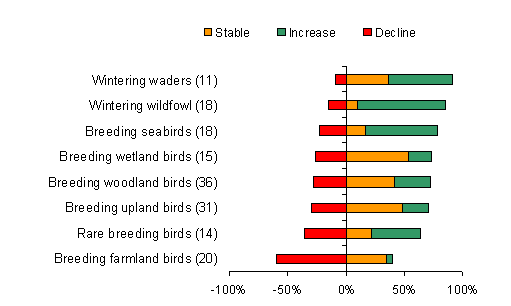 This page has been mothballed.
This page has been mothballed.
It is no longer being updated but we've left it here for reference.
Natural Heritage Reporting and Indicators: Statutory Requirements, Corporate Justification, User-community Needs
Ed Mackey - Head of Environmental Audit Unit, SNH
A suite of natural heritage indicators is under development by Scottish Natural Heritage (SNH), to be followed by external consultation. A proposed approach was presented and discussed at the workshop on 6-7 March 2003. Until a suite of natural heritage indicators is developed, the report here should be regarded as the views of the author alone, and not necessarily the views or intentions of SNH.
Statutory Requirements
1. The Natural Heritage Act (Scotland) 1991, which is the founding legislation for SNH, sets out the aim of fostering understanding. This can best be accomplished when information, which is relevant and reliable, is shared. Natural heritage trends have attracted considerable public, academic and professional interest. By reporting on a sub-set of trends, in the form of indicators, SNH can provide an overview of the state of the natural heritage through time.
2. The Environment Information Regulations 1992 (as amended) places an obligation upon public bodies such as SNH to make information available on request. We can be proactive in this by making trends web-accessible, thereby improving our operational efficiency and effectiveness. This should be linked to relevant web sites and portals, such as Scottish Executive environmental statistics, the National Biodiversity Network, or the European Environment Agency.
3. The Convention on Access to Information, Public Participation in Decision-Making and Access to Justice in Environmental Matters (Aarhus, 1998) requires public bodies to possess and update environmental information which is relevant to their functions. Environmental information needs to be effective and accessible, and made available to the public in a way which is transparent. Each party (i.e. the UK Government) is required at regular intervals, not exceeding three or four years, to publish a national report on the state of the environment. By making natural heritage trends information available on the web, and by periodically reporting on the state of the natural heritage, SNH can ensure that relevant natural heritage information is available for this and other such purposes.
4. A commitment to 21st Century Government in Scotland calls for public bodies to be open and accountable, with a commitment to customer service and the exploitation of new technology. Trends reporting can be held up as an example of that commitment by SNH. This would enable SNH also to supply the supporting facts and analysis relevant to SNH’s major policy decisions, as required under the Code of Practice on Access to Government Information 1997.
5. In short, there are good operational reasons, public interest, and a statutory justification for making natural heritage trends as widely accessible as possible. Natural heritage indicators would encapsulate this information in a highly accessible way.
Corporate Justification
6. Within the Corporate Strategy theme of caring for the natural world, the priority for trends and changes is to improve understanding of the way the natural heritage works by documenting changes and trends in it, and explaining these and their causes widely. Within the Research Strategy theme of understanding the causes and nature of change, the priority for environmental change is support for audit reports based on themes, geographical areas and issues together with the development of natural heritage and sustainability indicators.
7. It has been argued that sustainable development is not ‘out there’ waiting to be discovered and mapped, but by adopting the right set of indicators we can help to crystallise what that concept is, set priorities, monitor progress and shape future action and decisions. Furthermore, the existence of indicator sets are themselves indicators of whether or not a commitment to sustainable development is being taken seriously.
8. SNH has set out its policy aims in the Corporate Strategy. We need to be able to assert whether observed changes are converging with, or diverging from, our broad policy objectives. Based on best-available factual evidence, we should assess and report on the state of the natural heritage in a clear and consistent way.
9. The Corporate Strategy provides the policy framework for this. Indicators give practical meaning to that framework by showing through time the degree to which SNH policy objectives are being met, based on the factual evidence of natural heritage outcomes. They reflect the state of he natural heritage and so are relevant to, but are not the same as, indicators of Corporate performance.
User-community Needs
10. People are interested in the natural heritage: wildlife, landscape and landform, natural processes and natural beauty. We need to synthesise signals of change into a clear interpretation of the state of the natural heritage which is relevant to SNH purposes and which provides an authoritative public account.
11. Based on best-available factual evidence, we should assess and report on the state of the natural heritage in a clear and consistent way. A sub-set of natural heritage trends should therefore be specified for reporting as natural heritage indicators. The intention should be to define a suite of natural heritage indicators which can be reported upon regularly, with commentary by SNH on the current state of the natural heritage, issues and concerns.
12. Natural Heritage indicators should therefore relate to the state of the natural heritage itself, where SNH exerts a key influence but is rarely responsible for actions which affect it. For example, the Biodiversity Action Plan and the proposed Biodiversity Strategy for Scotland specify biodiversity outcomes from Habitat Action Plans (HAPs) and Species Action Plans (SAPs) for Scotland. Many of the actions are led and implemented by others. They nevertheless still contribute to the delivery of SNH policy objectives. The ultimate test is whether or not the natural heritage getting better or worse, through collective actions by SNH and others. Given that the natural heritage is mainly influenced by SNH’s advice to others, It is the state of the natural heritage itself which is the indicator.
13. The indicators could be maintained electronically, so that they remain current. The refresh period for an indicator will vary, but always be based on the most up-to-date information. An annual summary could be provided with the SNH Annual Report, noting any new developments or notable changes during the year. Periodically, a published overview could provide a more comprehensive account, with scope for further discussion, the description of examples, and illustration. This could take the form of a ‘State of the Natural Heritage’ report.
How should indicators be defined?
14. Indicators must be based on best-available data, but they should not be data-driven. They must be policy relevant, and sufficiently durable to remain so through time. They may be adapted and improved upon where appropriate, whilst maintaining a degree of consistency through time.
15. Taking the Corporate Strategy as the policy framework, the key characteristics of a candidate list are that it should be.
- Comprehensive – the full scope of policy themes and priorities is covered.
- Consistent – each policy area is treated in a like manner, and the indicators are nested within the larger library of natural heritage trends.
- Policy relevant – indicators give practical meaning to the Corporate Strategy
- Distinctive – like no others, they describe the natural heritage remit
- New – a genuinely new SNH product
- Inclusive – in reflecting relevant indicators elsewhere, particularly those which we ourselves have recommended to others.
- Operationally useful – they can be utilised for a range of promotional, advisory and educational purposes
- Efficient – they builds on existing activities and informs data priorities
- Effective – they are relevant to SNH and others
16. Within the DPSIR framework , the focus of interest
here is on measures of the state of the natural
heritage. An example of a state indicator might
be trends in the range and abundance of wild
birds:
Bird population trends: long-term Changes in range or abundance: 1960s-70s to 1990s

17. Through future collaborative research between SNH, the Macaulay Land Use Research Institute and the Centre for Ecology and Hydrology, it is hoped to explore the cause-effect relationships between interacting components of social, economic, and environmental systems:
| Driving forces of natural heritage change |
| Pressures on the natural heritage |
| State of the natural heritage |
| Impacts on e.g. ecosystems |
| Response of society |

